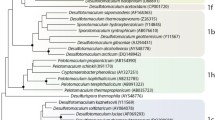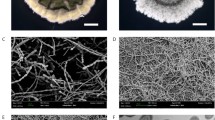Abstract
Three distinct strains (KL1, KS1, and KS2) of facultatively chemolitho-autotrophic bacteria able to use carbon disulfide or carbonyl sulfide as sole energy substrates were identified as novel strains of Paracoccus denitrificans. Evidence for their identity as biovars of P. denitrificans and as close relatives of Paracoccus versutus is based on their DNA composition, total sequencing of the genes for their 16S rRNA, muropeptide profiles, amino acid composition of peptidoglycan, kinetics of murein degradation by lysozyme, possession of large plasmids (91–98 kb) and megaplasmids (> 450 kb), and plasmid transfer between the strains and with P. denitrificans and P. versutus. No functions have been identified for the 91- to 98-kb plasmids of strains KL1 and KS2, but curing strain KL1 of its plasmid did not affect growth on carbon disulfide, thiosulfate or succinate. Emendation of the formal description of Paracoccus denitrificans is presented. Autotrophic growth on carbon disulfide and thiosulfate was confirmed by 14CO2 fixation. Evidence is presented for initiation of carbon disulfide oxidation by an NADH-dependent oxygenase. Cell-free extracts catalyzed (1) NADH-stimulated uptake of oxygen in the presence of carbon disulfide, and (2) carbon-disulfide-stimulated oxidation of NADH. The activity was not sedimented at 50,000 ×g. Intermediates in aerobic carbon disulfide metabolism were shown by GC and GC/MS to include carbonyl sulfide and hydrogen sulfide, but anaerobic production of COS and H2S from carbon disulfide did not occur. SDS-PAGE of cell-free extracts showed polypeptides that were unique to growth on carbon disulfide, common to carbon disulfide and carbonyl sulfide, or found after growth on carbon disulfide, carbonyl sulfide or thiosulfate. The possible identity of these as proteins involved in sulfur compound metabolism is discussed.
Similar content being viewed by others
Author information
Authors and Affiliations
Additional information
Received: 13 March 1997 / Accepted: 21 May 1997
Rights and permissions
About this article
Cite this article
Jordan, S., McDonald, I., Kraczkiewicz-Dowjat, A. et al. Autotrophic growth on carbon disulfide is a property of novel strains of Paracoccus denitrificans. Arch Microbiol 168, 225–236 (1997). https://doi.org/10.1007/s002030050492
Issue Date:
DOI: https://doi.org/10.1007/s002030050492




